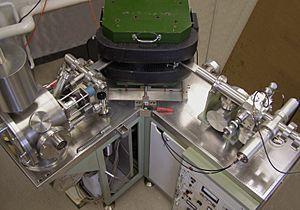Isotope analysis facts for kids
Isotope analysis is a way to study different versions of chemical elements, called stable isotopes, found in things like plants, animals, and rocks. Think of isotopes as different "flavors" of the same element. By looking at the amounts of these isotopes, scientists can learn many things. For example, they can figure out how energy moves through a food web, what past climates were like, what ancient people or animals ate, and even where food comes from. Scientists use a special tool called a mass spectrometer to measure these isotopes. This machine separates isotopes based on their weight.
Contents
How Isotopes Get Into Our Bodies
When we eat and drink, different isotopes, like those of oxygen, enter our bodies. These isotopes then become part of our bones and teeth.
Our bones are always changing and rebuilding themselves. This means that the oxygen isotopes in your bones will show where you have lived for the last 10 years or so. If you move to a new place and stay there for a long time, the isotopes in your bones will start to match your new location.
Teeth, however, do not change once they are formed. So, the oxygen isotopes in your teeth show where you were born and grew up. By looking at baby teeth, scientists can even figure out when a child stopped drinking breast milk. This is because breast milk has different oxygen isotopes than other foods.
Teeth are generally stronger and keep their original isotope signals better over time than bones.
What Isotope Analysis Can Tell Us
Isotope analysis is used in many different science fields. It helps us understand living things, the Earth, and the environment.
In Archaeology
Archaeologists use isotope analysis to learn about ancient times.
Understanding Ancient Diets
Scientists can study bones, hair, or shells from ancient sites. By looking at isotopes of Carbon, nitrogen, and zinc, they can figure out what people and animals ate long ago. These isotopes can also help understand how groups of people moved around or traded with each other.
- Carbon isotopes help show what kind of plants were eaten. Some plants, like wheat and rice, are called C3 plants. Others, like millet and sugar cane, are C4 plants. Carbon isotopes can also tell if food came from the sea, fresh water, or land.
- Nitrogen isotopes can show if ancient farmers used manure to fertilize their crops. They can also give clues about the environment, like if the soil was dry or wet.
By studying both carbon and nitrogen isotopes, scientists get a good picture of what ancient diets were like.
Finding Where Ancient Materials Came From
Isotope analysis is also great for figuring out where ancient objects came from. Scientists can compare the isotopes in an artifact, like a metal tool or glass, to isotopes found in different mines or quarries. This helps them trace trade routes and understand how ancient societies connected. For example, in the Bronze Age, lead isotope analysis helped show where metals used in the Mediterranean came from.
In Ecology
Every living thing has different isotopes. For example, most carbon is carbon-12, but a small amount is carbon-13. The amounts of these isotopes can change based on how living things grow and interact with their environment. Ecologists use isotopes of carbon, nitrogen, oxygen, hydrogen, and sulfur to study how ecosystems work.
In Forensic Science
Isotope analysis is becoming useful in solving crimes.
- Hair analysis: Our hair grows about 15 centimeters (6 inches) a year. The isotopes in our hair come from the food and water we consume. Since the isotopes in drinking water vary from place to place, scientists can analyze a strand of hair to figure out where a person has been recently. This can help investigators in cases where other clues are missing.
- Explosives analysis: Scientists can also use isotope analysis to see if different samples of explosives came from the same place. By comparing isotopes like carbon, hydrogen, nitrogen, and oxygen, they can even sometimes find out which country an explosive came from.
For Tracing Things
Isotope analysis can help trace the origin of many things. It is used to find out where food or timber comes from. It can also track how pollutants, like nitrates, move through the environment.
In Geology
Isotope geochemistry is a field that uses isotopes to study the Earth's processes.
In Hydrology
In isotope hydrology, scientists use isotopes in water (like hydrogen-2 and oxygen-18) to understand where water comes from, how old it is, and how it flows through rivers and underground. Changes in water isotopes can show how much water evaporates or how much rain soaks into the ground.
For Studying Past Climates
The amounts of oxygen-18 and oxygen-16 in ice and deep-sea cores can tell us about past temperatures.
During very cold periods, like ice ages, more of the lighter oxygen-16 evaporates from the oceans, leaving more of the heavier oxygen-18 behind. Tiny sea creatures called foraminifera build their shells using oxygen from the water. So, their shells record the oxygen isotope ratio, which tells us about the ocean temperature when they lived. When these creatures die, their shells sink to the seafloor, creating a long record of Earth's climate.
Similarly, ice cores from glaciers also hold clues. During warmer times, more of the heavier oxygen-18 evaporates and gets trapped in the ice. So, the oxygen isotopes in ice cores give us a "mirror image" of the climate record found in ocean sediments. These records show that Earth's climate has changed in cycles over thousands of years.
See also
 In Spanish: Análisis isotópico para niños
In Spanish: Análisis isotópico para niños


